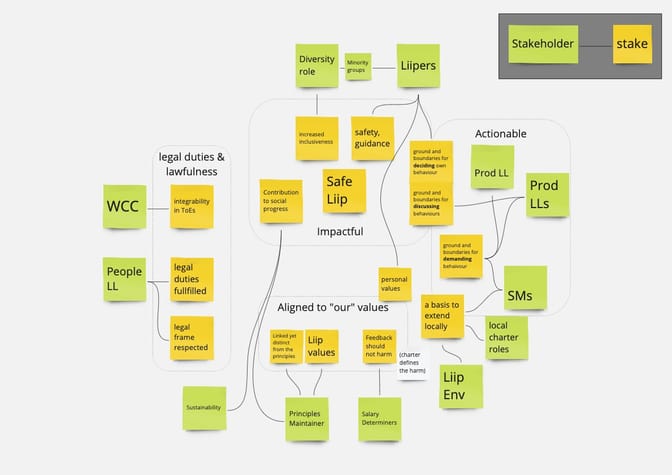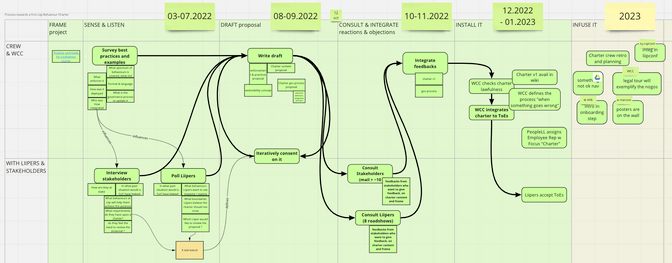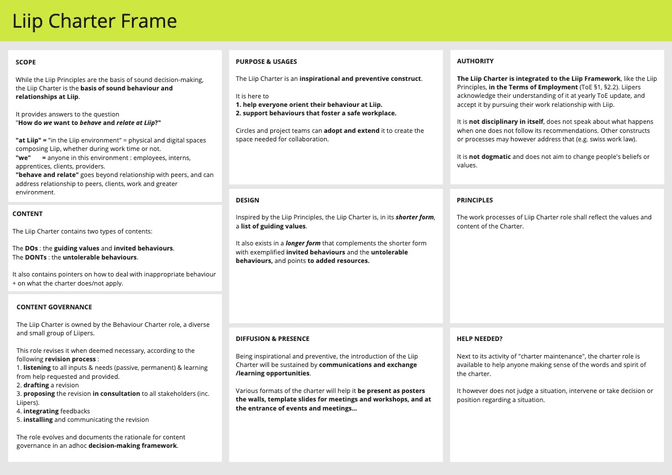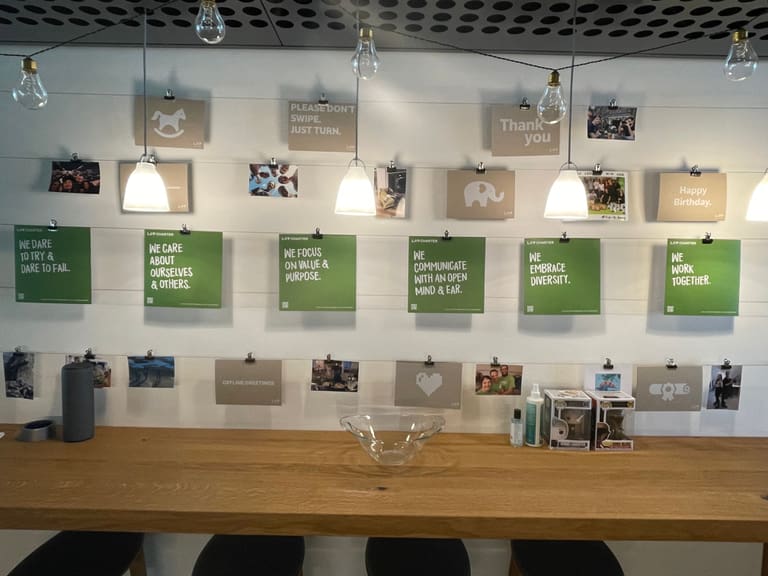This article shares the why and how a company where self-organisation, autonomy, and freedom are organisational key elements came to install such behavioural guidance.
The time had come
Liip has this very unique work culture. The founders’ values, the nature of agency work, the adoption of agile and Holacracy methods, the adoption of hybrid work… waves of organisational factors have shaped Liip’s work culture into something quite specific, where individuality and autonomy (along collaboration) are no faint words, yet, also, double-edged swords.
Early 2022, a sum of factors invited our People circle (aka the HR team) to conclude that it was time for some kind of code of conduct on behaviours, in order to make explicit some implicit expectations. Notably:
- Diversity on many dimensions (cultural origins, generations, gender, beliefs, language, work preferences (time & place), relational strategies…) had continuously increased along Liip’s growth and would continue to do so, leading to more misunderstandings and disagreements on expected and acted behaviour.
- We were starting to sense that remote work was potentially acting as an amplifier of diversity of behaviour and a probable amplifier of disconnectedness, maybe even an inhibitor of empathy, with colleagues having less opportunity to empathize with one another’s perspective and realities.
- In a “culture of fierce autonomy”, employees and employer roles had too little organisational ground to address what they deemed inappropriate behaviour, a notion with a values component.
Choosing the right process
We could have simply copy-paste-adapt-ed a best-in-class example or worked on the basis of the templates provided by the Swiss government. Yet, we knew bluntly installing and imposing it on our employees would have been a counterproductive move.
We could also have gone co-creative, with some kind of large open-space event, yet the wisdom of the crowd wasn’t the only source of truth to be considered here: we knew we would need to deal with roles and employees as stakeholders, as well as with subtle and multifaceted legal constraints.

We thus chose a middle way, and went for a participative process where a small and diverse work group, anchored in a role of the People circle, would lead the work and onboard employees and stakeholders in the process.
The process we followed:
- Sense & listen: refining the problem space and listening to all stakeholders upfront on their needs and perspectives
- Shape: drafting a first charter, shaping its overall concept and governance
- Propose & integrate feedbacks: sharing the draft with employees and stakeholders, gathering and integrating their inputs, concerns and objections
- Finalise & install: finalizing charter document and anchoring it in the terms of employment
- Infuse: sustaining awareness of its existence and implications

Although the concrete details of each step changed on the way, having this overarching process and timeline (as well as a fair amount of adaptability) helped us stay on track and clarify participation and expectations of/on every involved party.
Launching, flying and landing
The road ended up being a beautiful, though sometimes bumpy, journey.
Sense & listen
After thorough identification of stakes and stakeholders linked to a behaviour charter, we quickly interviewed the sooner and polled the latter on their needs and thoughts on the topic. There were a few vocal ones with clear opinions, but most had fuzzy thoughts and first inputs on it.
However, doing so provided us with an important insight: Roles and employees were rather aligned on the values the charter should embody, providing us with some kind of value-scope to address.
In our interactions with all these people, we identified patterns in the way individuals related to the idea of establishing a behaviour charter. Based on this insight, we developed 3 personas to describe how people would likely relate to the idea, the initiative and its end-product. Working on and with those personas helped our work group to cope with the sometimes vivid reactions we were facing and adapt the process to meet the most underlying needs, along the way.
Polling early was also a very interesting and effective way to prime employees and stakeholders on what was coming.
We reviewed the literature about charters and codes of conducts and looked for inspirations and best examples.
One thing that we overlooked yet should have done at this point: look at the legal framework and the material and guidance the state provides for a faster start in the topic.
Shape
In parallel to preparing the work on the charter draft, we consciously shaped the charter frame: all the whereabouts around the charter itself. This helped us orient the content work immensely and made it very effective.

A key element of this frame was to upfront “decide how to decide” on the content of the charter: we shaped a charter amendment process.

Content work itself, I feared, would be difficult. I dreamed of co-creation by the work group, since everyone has soaked in so much intelligence on the topic, but the idea of writing with 5 hands felt a daunting one. I thus proposed that everyone drafts their own ideal charter that had formed in their minds during those early months of work. We then discovered them together, and discussed them together in terms of strengths and weaknesses, then decided to pick one as the basis for further developments.
It was a beautiful moment to discover and share about those often very intimate and engaged writings, reflecting the intelligence and values of each individual.
Propose & integrate
For the second round of interactions with employees and stakeholders, we decided to hold all-employees sessions where we could explain the charter draft, the whereabouts of the projects, answer all questions, and gather the feedbacks and concerns. We organised a handful of online sessions to ensure every employee could attend at least once.
One thing we thoroughly worked upfront was the stance and the facilitation of those sessions. We knew we would be facing a handful of strong (emotional) voices. We knew putting them down was not an option: we knew we needed to interact by the very virtuous values the charter draft was containing.
In this process, we sensed the magic of keeping people onboard and giving them a voice, welcoming with respect and attention every one of their messages. At the end of every session, we followed up with everyone who voiced a concern or strong objection. Every conversation we held enriched our perspectives on the topic.
Finalise & install
That step was almost a breeze: merely synching with Legal and integrating the charter in internal policies and documents.
Infuse
The behaviour charter took effect on Jan. 1, 2023, as an integral part of our renewed terms of employment. Acceptance by the employees happened seamlessly.
Signing off a policy document does not mean behaving according to it. However, we believed the participative process had already moved minds forward and went for a low-key diffusion process: no big-bang event, communication, sermon or whatever…
Impact and beyond
Here we are, we have had a behaviour charter for 16 months, it is part of the foundational elements of our human and organisational system. New employees get to read and sign it. Posters in the offices highlight some of its key invitations.
Have we all turned into angelic, virtuous beings? Nope. But the “behaviour nogos” are clearer in our minds, and as of 2024-04, no ”charter breach” has been notified to our “guardian of personal integrity”.
Interestingly, the participative process itself potentially had an effect, as a mid-2022 job satisfaction survey showed: the values rank within the company shifted, with respect and diversity gaining importance.

We do actively curate a backlog of improvements we plan to integrate for 2025.
Another area we want to further develop, is to bring it into our client relationships. We see it as a great opportunity to foster a safe work environment for everyone and strengthen each partnership we build with clients.

